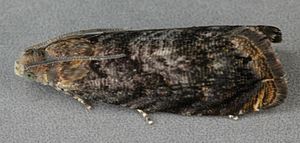Plum moth
| Plum moth | ||||||||||||
|---|---|---|---|---|---|---|---|---|---|---|---|---|

Plum moth ( Grapholita funebrana ) |
||||||||||||
| Systematics | ||||||||||||
|
||||||||||||
| Scientific name | ||||||||||||
| Grapholita funebrana | ||||||||||||
| Treitschke , 1835 |
The plum fruit ( Grapholita funebrana ) is a butterfly (moth) from the family of Winder (Tortricidae). The species is considered a pest in fruit growing . The moth Hedya pruniana is also sometimes referred to as the plum moth (or plum bud moth ).
features
butterfly
The moths have a wingspan of 12 to 15 millimeters. Their elongated triangular fore wings are narrow at the base and have a curved front edge. They are dark gray-brown in color, but lighter in the fringe area, brownish to ash-gray in color. Dark, black-brown diagonal hooks and finer dashes run along the leading edge of the wing from the base, which merge into stronger hooks from the middle of the wing. In between the wings are dark gray, more rarely whitish and finely divided towards the tip. After the first quarter of the leading edge of the wing, a slash is drawn to form a double, flat-inflected dark line that runs across the wing and becomes increasingly thick. Behind this, on the inner edge of the wing, there is often a wide, square, white-gray spot that extends to the wing fold and that is divided by a middle, thicker and two finer lines. Not infrequently, however, the bright spot is not very clearly developed. A strong, dark tick in the middle of the wing leading edge widens to a dark brown, rather steep bias band, which is sharply and somewhat jagged towards the edge and blurred towards the base of the wing. Dorsally it is broadly triangularly darkened. There is no light mirror on the outer edge of the wing, but there is an oblique row with fine black dots on a gray background. The outer edge of the wing is lined with yellowish-gray-brown, with a fine black dividing line between the edge and the wing.
The more trapezoidal rear wings have a pointed apex with a flat hem underneath. They are brown-gray and have a pale brownish, slightly darker colored edge with a brown-gray dividing line. The head and thorax of the butterflies are dark gray-brown, their abdomen is brownish-gray.
The moths are only slightly variable in their coloring. In some specimens the gray of the scaling of the forewings is more pronounced. A sexual dimorphism , ie differences between males and females are not pronounced.
Caterpillars
The caterpillars are colored carmine red and have a dark brown head. Your neck and anal shield are brownish.
Occurrence
The species is widespread and common in the Palearctic . It inhabits forests, gardens and orchards.
Way of life
The adults occur from April to September and fly in the evening and at night. The females lay their eggs on the lower side of the fruit. After hatching, the caterpillars quickly drill directly into the fruit and feed on its interior.
The caterpillars appear in two generations in June and July, first in the heart shoots of their food plants, and in August and September in the fruits of the plants. They are found on apricots ( Prunus armeniaca ), sour cherries ( Prunus cerasus ), common bird cherry ( Prunus padus ), pears ( Pyrus ) and other rose plants (Rosaceae), such as the plum ( Prunus domestica ). The caterpillars of the first generation can fall to the ground with the fruits that are prematurely shed from the trees, the second generation can also fall to the ground with the fruits, or they can be roped off with a silk thread. Pupation takes place in a web that is laid by the caterpillars in the moss on the tree trunks or between pieces of fallen bark or rotten wood on the ground. This is also where the second generation hibernates.
Harmful effect and control
A colorless droplet of resin often sits at the hole opening of infected plums. Infested fruits become emergency ripe prematurely and fall off early. In the case of plums, if the harvest is abundant, this can also lead to a positive thinning of the curtain. The collection of fallen fruit reduces the infestation pressure in the following year if the caterpillars have not yet left the fruit. The moths can be detected and controlled by pheromone traps from April / May. For biological control are jewel wasps of the species Trichogramma cacaeciae sold that need to be exposed to year depending on Plum variety two to three times.
Individual evidence
- ↑ a b c d e f g Peter V. Küppers: Kleinschmetterlinge. Recognize, determine . 1st edition. Fauna-Verlag, Nottuln 2008, ISBN 978-3-935980-24-1 , p. 282 .
- ↑ a b c Julius von Kennel: The Palaearctic Tortriciden. A monographic representation. in Zoologica - original treatises from the entire field of zoology. Booklet 54, E. Schweizerbart'sche Verlagsbuchhandlung, Stuttgart, 1921 pp. 650f.
- ↑ a b c d Note on the control of plum moth and plum sawfly Leaflet for house and allotment gardens June 2008, Plant Protection Office, Chamber of Agriculture Lower Saxony
- ↑ Agricultural Technology Center Augustenberg : Information for the hobby gardener - plum curler (plum maggot) (online: PDF ( Memento of the original from May 22, 2014 in the Internet Archive ) Info: The archive link has been inserted automatically and has not yet been checked. Please check the original and archive link accordingly Instructions and then remove this notice. )
Web links
- Lepiforum e. V. Taxonomy and Photos
- Grapholita funebrana at Fauna Europaea. Retrieved May 22, 2014

